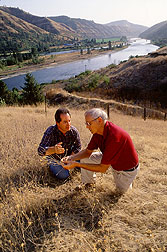Weevil Gets Upper Hand With Unruly Weed
Bright-yellow flowers carpet canyon slopes above the Clearwater River in Idaho. But its a small, denuded patch that excites scientists. That's because the flowers belong to the noxious weed called yellow starthistle, and the bare patch is one of the first signs of success in the biological control of the weed.
A small weevil, Eustenopus villosus, gets credit for cutting the plant down to size.
In their Eurasian homeland, insects and disease organisms keep yellow starthistle at low levels. But when the spiny weed entered the United States in the mid-1800s—probably in a hay shipment—it found no natural enemies to hinder its spread. Now the weed inhabits tens of millions of acres in California, Idaho, and other western states.
"When the thistle takes over areas like river canyons, it displaces other vegetation and makes the land virtually worthless for livestock and wildlife," says University of Idaho entomology professor Joseph McCaffrey. The weed is toxic—sometimes fatal—to horses. Other animals will eat only very young starthistle plants.
Biological control of introduced weeds has been an ongoing priority nationwide for ARS. Preliminary work on yellow starthistle began in the 1960s, but the research program shifted into high gear in 1983.
"We investigated several weevils and flies that appeared to keep yellow starthistle in check in its native habitat," says ARS entomologist Stephen L. Clement, who works at the Western Regional Plant Introduction Station in Pullman, Washington. "Then we tested the insects at our European facilities to make sure they wouldn't feed on desirable plants in the United States."
Since then, with approval from USDA's Animal and Plant Health Inspection Service, six of the insects have been imported, and five have become established. So far, the Eustenopus weevil—imported in 1990—has been the most effective.
After ARS scientists release the insects, collaborators like McCaffrey monitor and redistribute them to new sites. "Fewer than 200 weevils were initially released at Clearwater," McCaffrey says. "Now we use the site as a nursery to collect weevils for use in other weed-infested areas. We've moved at least 10,000 insects," he says.
Sites that show dramatic weed reduction are gratifying, but biological control success is usually hard to measure.
"This weevil is valuable because it attacks the weed twice," says ARS entomologist Joseph K. Balciunas. Adults eat developing buds. Females lay eggs in older buds that remain, and the larvae that hatch eat most of the seeds before they mature.
However, in California, environmental conditions allow the weed to produce more buds—and seeds— after the weevils have completed their life cycle for the year.
"Biological controls play an important role in reducing the number of seeds the weed produces every year," he says. "But in some areas where plant numbers are reduced, individual plants grow larger to produce more seed."
To better understand the weed, Balciunas plans to compare its seed production in the United States with that in Turkey, where yellow starthistle is native. "The weed doesn't persist in its homeland like it does here. If the soil there is undisturbed, the weed disappears within 5 years," he says. "If we can discover why that happens, it will give us clues for controlling the weed." — By Kathryn Barry Stelljes, Agricultural Research Service Information Staff.
Joseph K. Balciunas is in the USDA-ARS Exotic and Invasive Weeds Research Unit, 800 Buchanan St., Albany CA 94710; phone (510) 559-5975, fax (510) 559-5963.
"Weevil Gets Upper Hand With Unruly Weed" was published in the February 1999 issue of Agricultural Research magazine.







